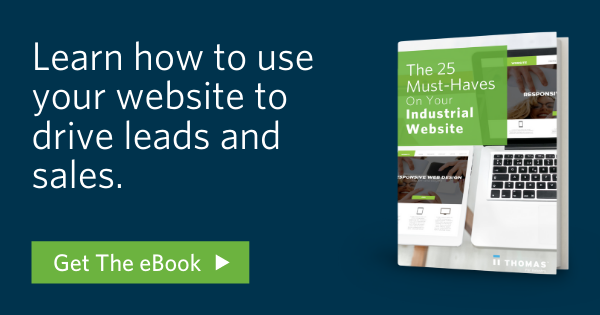If you’re an OEM, industrial distributor, or custom manufacturer, these statements might sound pretty familiar:
- “We need to talk to prospects in order to qualify them.”
- “Too much information on my site would give my competitors an advantage.”
- “We get all of our new business from word-of-mouth.”
- “A new website won’t help me get new business because my current website doesn’t, either.”
It’s understandable — it’s not easy doing what you do. But if you want to start bringing in more new customers, you may want to rethink your approach. That’s because more of your buyers and competitors are doing business digitally. Supplementing your traditional growth methods with an updated website and inbound marketing strategy helps out where cold calls and word-of-mouth fall short.
 Do Manufacturers Really Need An Updated Website?
Do Manufacturers Really Need An Updated Website?
There are many good reasons to update and redesign your website — to make it mobile responsive, to bring it in line with your current branding, or perhaps to move onto a new Content Management System (CMS) or Marketing Automation platform. But the most important overall goal of accomplishing all the above for businesses is to generate more leads.
So ask yourself this, “Do I want more business?”
If the answer is yes, then yes — you need an updated website.
Before the digital transformation of industrial sales and marketing, businesses that simply had a website were already standing apart from competition. You may have had, or currently have, a website that looks like this:
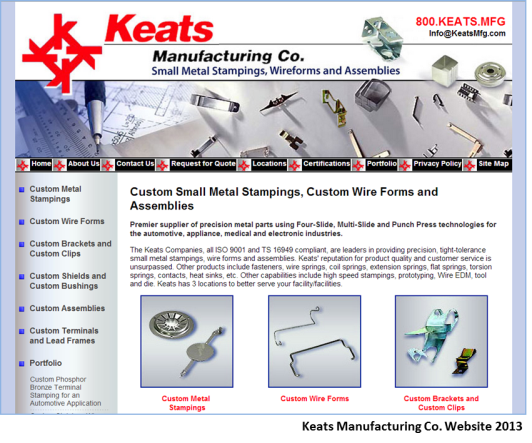
That was the standard back in 2013. But today, a site like that won’t get the job done. If you haven’t updated your website in years or months, you are definitely due for an upgrade. Other signs your website is out of date include:
- Not being able to view your website correctly on your phone
- You’re seeing a “Not Secure” notification on your browser
- You haven’t included new images of your latest products or facility
Industrial buyers now require more information and quality content when conducting research for services. The same website from Keats Manufacturing,
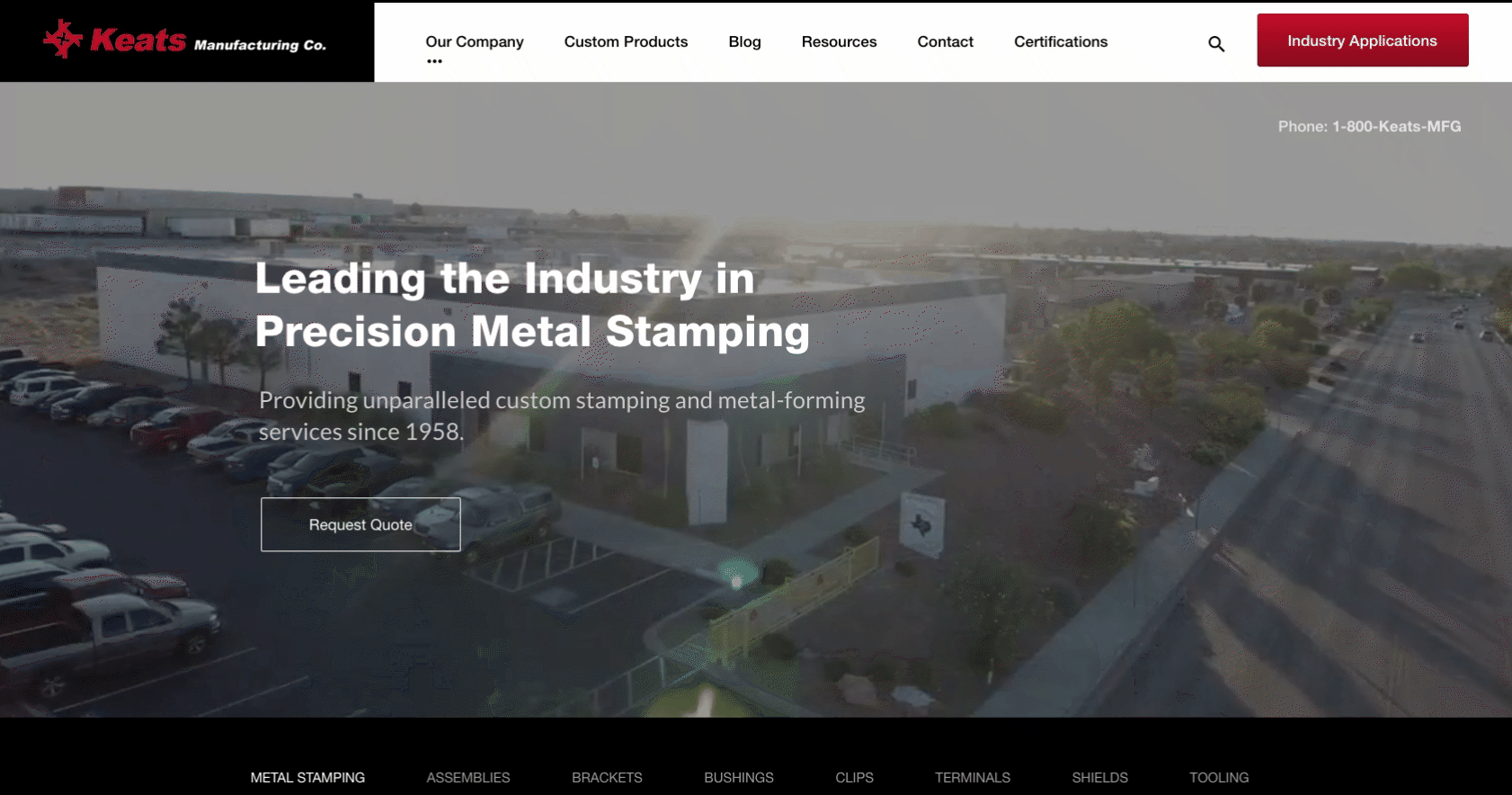
This updated website allows Keats to showcase many aspects of their business, including:
- Services and capabilities
- Company location
- Expertise
- Certifications
held - Current shop capacity
By communicating this information to Keats’ buyers online, Keats is able to attract and convert targeted more customers.
Meeting The Needs Of Industrial Buyers Today
According to our 2019 Industrial Buying Habits Survey, 80 percent of B2B buyers utilize search engines when sourcing new suppliers (making it the second-most utilized tool for buyers, behind only the 71 percent of buyers who use Thomasnet.com). That’s more than word-of-mouth referrals (65 percent) and even internal company-preferred databases (41 percent).
Furthermore, when sourcing new suppliers, more buyers (73 percent) pay attention to a potential partner’s
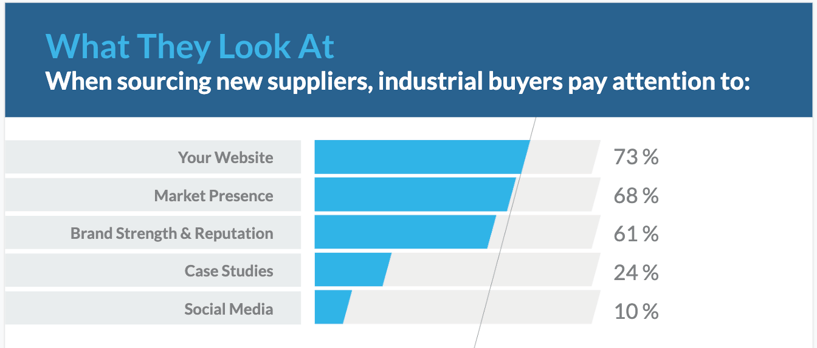
Buyers are looking on your website. If it doesn’t exist, or if it reflects poorly on your company, then they are likely to take their business to your competitors. With Thomas WebTrax, you can turn your anonymous web traffic into sales leads. (Click here to learn how you can get that data and who’s looking at your website.)
What Are The Main Components Of A Website?
As your business grows, your website should be updated to reflect the changes in your company like new products, services, certifications etc. Designing your website will depend on the paths of your user (we’ll touch more on understanding you buyer’s perona later) but here are the main components your website navigation should start with:
- A homepage: This is the first page that most people see. Consider a design that has a navigation and CTAs people want to click on. Check out how Cyclonaire’s navigation below makes it easy for users to find what they’re looking for with the top menu of blue boxes and a Representative Locator, Customer Login, a Search function, and social media buttons in a contrasting color.
See more examples in 25 Website Must-Haves That Drive Leads & Sales
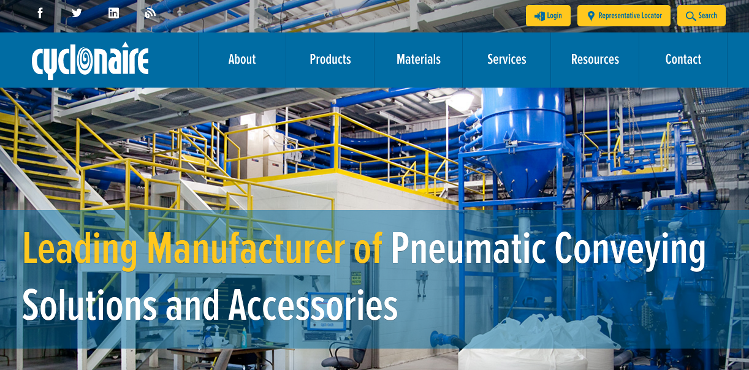
- An About Us page: Chances are, you already have an About Us page. But we’ve noticed manufacturers and industrial companies with About Us pages that are missing key information buyers are looking for, like ISO certifications and quality policies. Learn more: The Must-Haves For Your About Us page.
- Product pages: Your product data and your website need to work together to get you quality leads. With Thomas Connect, OEMs and distributors’ website upgrade is built with an eCatalog experience that solves data challenges and drive sales simultaneously.
- A blog or resources page: A blog is an easy way to create content on an ongoing basis, solidify your credibility in the industry and increase SEO. Ensure you have a strong word count per blog — ideally 700 words or more. Learn more in 12 Ways To Improve Your Manufacturing Blog.
- A Contact Us page: You’d be surprised how many manufacturers and industrial companies miss out on the opportunity to add meaningful information on their Contact Us page. You need to list multiple options people can contact you — phone, address, email, and a form. Read more about a Contact Us page’s best practices in this post.
How Do You Get Started Building A Lead Generation Website?
As you’ve already learned, optimizing your website for lead generation is not a set-it-and-forget-it task. There are a few quick fixes to get your website to increase clicks and engagement, but a complete website redesign requires a lot of careful planning. To keep things simple, we’ve listed out for the first 10 steps you should focus on first.
1. Benchmark Your Current Metrics
Before you start thinking about anything, document your current performance metrics (if you have a website; if you don’t have a website and have made it this far in our post, please give us a call). Start by analyzing your existing site over its history, including:
- Number of visits/visitors/unique visitors
- Bounce rate
- Time on site
- Current SEO rankings for important keywords
- Domain authority
- Number of new leads/form submissions
- Total amount of sales generated
If you don’t have access to this information, then we absolutely recommend adding a tool like Google Analytics for better tracking and visibility into site performance. It’s critical you are measuring the performance of your website from the start. Insight is everything for a marketer.

2. Determine Your Marketing Goals
Be really clear about why you’re upgrading and redesigning your site in the first place. Identify measurable, achievable outcomes, and then communicate your goals with your team, designer or agency. Many businesses focus on just getting more visitors or more page views, and although these are positive signs, the most important question you should be asking is “Does this traffic translate into more leads?” Every business is different — from a small machine shop to a larger enterprise — but it’s important to choose goals that directly lead to your business’ bottom line.
Remember that your website goals (and all your other marketing goals) should be “SMART” — the acronym for Specific, Measurable, Attainable, Relevant, and Timely.
With that in mind, consider the following goals for your website redesign:
- To increase the number of monthly qualified leads by 22% six months from website redesign launch
- To improve new service awareness by 10% by the end of the year
- To increase the website’s conversion rate by 7% by the end of the quarter
- To increase website traffic by 50% in the next six months.
Many of these goals are dependent on each other. For example, in order to get more conversions, you need to increase traffic while decreasing the bounce rate.
Thomas Tip: See Which Channels Drive Your Best Traffic And Leads

Do you know which of your marketing channels are bringing in the most customers? A Marketing Automation tool like HubSpot lets you see your top performing channels so you can make your marketing investments smarter.
- Social Media Measurement: Understand how social media is driving leads.
- Organic vs. Paid: See how much of your search traffic can be attributed to search engine optimization, and how much you’re paying for.
- Buyers vs. Browsers: See which channels brought in serious leads versus website visitors who just came to look around.
3. Inventory Your Marketing Collateral Assets
While a redesign is a great way to improve results, there are countless ways it can hurt you. Your existing website contains a lot of assets that you have built up, and losing those during a redesign can damage your marketing. For instance, such assets might include:
- Most shared or viewed content
- Most trafficked pages
- Best performing keywords you rank for and associated pages
- Number of inbound links to individual pages
For example, if you remove a page that has a higher number of inbound links, you could lose a lot of SEO credit, which could decrease keyword rankings.
Keep in mind that many web designers don’t consider this step because they are not marketers. That’s why it’s important to work with a team that understands all aspects of your business and are experts on both website design and content marketing. Read more on your options: Train In-House Or Hire An Agency, Freelancer?
4. Analyze The Competition In Your Industry
While we don’t recommend obsessing over your competitors, it helps to know how you stack up.
- Get a Digital Health Check to get a report card of how your website and marketing is performing today.
- Research your competitors so you are aware of their strengths and weaknesses.
- Take a look at their websites, note what you like and what you don’t. BUT, this is not meant to copy them. That’s the last thing you want to do. Instead, you’ll uncover what you can do better.
HubSpot also makes it easy to set goals and see where you stand on traffic, inbound links, conversion rates, lead generation and other important metrics. Once you run the analysis, put together an action list of what areas you can improve and what you can do differently than your competitors.
5. Identify Your Unique Selling Proposition
Before you begin crafting your content, be clear about your Unique Selling Proposition (USP) so that it is consistent across your entire website. If you attract a high number of unique visitors, or you’re a new business, your visitors might not be very familiar with you and what you do. You need to demonstrate that what you do is right for them, and why they should stay on your website and buy from you.
Not creating a unique selling proposition is one of the most common mistakes we see manufacturers and industrial companies make.

6. Create Buyer Personas
Your website is not just about you. Your visitors ask, “What’s in it for me?” Speak to them in their language by creating content specifically for your buyer personas.
A buyer persona is when you slice your marketplace into individual groups of people. They are fictional representations of your ideal customers, based on real data about customer demographics and online behavior, along with educated speculation about their personal histories, motivations, and concerns.
Here’s how you can begin to create buyer personas and utilize persona targeting effectively:
- Segment by Demographics: Start developing personas by researching your existing customer base to identify the most common buyers of your products and services. You may have several different types of buyers, so give each one a detailed description, including a name, job title or role, industry or company info, and demographic info.
- Identify Their Needs: What are the biggest problems they are trying to solve? What do they need most? What information are they typically searching for? What trends are influencing their business or personal success?
- Develop Behavior-Based Profiles: What do they do online? Are they active on Twitter, Facebook, or other social networks? What kind of search terms do they use? What kind of information do they tend to consume online? Which of your products do they spend the most time researching? How do they use those products?
Use your website to match your messaging to the needs of different buyer personas. Build your pages into categories to fit these personas, or offer content in a way that your prospects can easily find what’s relevant for them. To learn more about the the top 3 individuals that influence the industrial buying process, download our guide, Persona Targeting For Manufacturing Companies.
7. Implement An SEO Strategy
Getting found online is essential to improving the rest of your site metrics. If no one is coming to your site, how can you increase leads, downloads, or sales?
Here are some tips to designing your site for search engine optimization (SEO):
- Document Your Most Search-Valued Pages: As mentioned in step three, know what pages have the strongest SEO juice, the most traffic, inbound links, and keywords rankings. If you plan to move highly ranked pages, create proper 301 redirects so you don’t lose any of that value.
- Create A 301 Redirect Strategy: This may be THE most important step in terms of retaining traffic and rankings. Simply create a spreadsheet to record and map out your 301 redirects. You may also have heard or seen 404 page errors. Check out how they relate to a 301 redirect in our blog, What Does A 404 Error Mean?
- Do Your Keyword Research: For every page, pick one to two keywords that the page will focus on. Once you determine the keyword(s), use on-page SEO tactics, such as internal link building and optimizing your header tags (H1, H2, H3, etc.)
Learn more about SEO with the eBook How To Increase Your SEO Traffic In Just 30 Days
8. Identify Calls-To-Action
Calls-to-action are the elements on your website that drive visitors to take an action, whether it’s a whitepaper download, contacting sales, or product purchase. Your website shouldn’t be a static brochure but should prompt your visitors to do something that further engages them with your brand.
When you’re planning for the redesign, think about all the potential opportunities for conversion. For example:
- Ebooks and whitepapers
- Contests and promotions
- Product purchases
- Email newsletter subscription
- Free trial
- Contact us / consultation / demonstration / etc.
While the “design” of your website is important, focus on functional. Make sure there are plenty of calls-to-action so you don’t lose visitors and check out 30 Industrial Lead Generation Tips, Tricks, and Ideas to see how to put your CTAs in action.

9. Create An Ongoing Content Strategy
If you have more content, on average you will have more website visitors and grow your business faster. A 100-page website will beat a 10-page website 99% of the time. And a 500-page website is even better, especially when it includes a constant flow of fresh content. Develop a content marketing strategy and continue to add more and more material to your website over time.
Here are some suggestions to get started with content marketing.
10. Choose A Strong Content Management System
There are endless things you can update on your website, but what’s crucial is the foundation of your website — the content management system (CMS). Don’t worry, using a CMS doesn’t have to be daunting. That’s why we recommend using WordPress for your industrial site — 30% of all websites are powered by it! Wordpress offers plugins for testimonials, a powerful selling tool, and it’s mobile-friendly — a must to provide an optimal user experience for your leads.

More Advice To Increase The Quality Of Your Leads
Any website built today should include these basics: a homepage, product pages, industry resources and a Contact Us/About Us pages. But there’s more to the basics that can really make your website awesome, including:
- Landing Pages: Landing pages with calls-to-action are critical lead generation components. Create awesome landing pages as part of the redesign for your offers and assets, like whitepapers and guides.
- RSS Subscription: RSS allows some content from your website to be automatically pushed out to other websites and people, increasing the reach of your content.
- Social media icons: Add social media sharing buttons/links to all your pages so your readers can share your expertise to their networks. You can use tools like ShareThis or AddThis.
Check out 25 Website Must-Haves That Drive Leads and Sales for more examples. These extra tips take a lot more planning and technical work — remember, a website is not a silo. Its integration with other functions, such as social media and email marketing is critical. There’s still a lot more work involved keeping your marketing strategies are aligned, continuously optimizing your website, and reporting on the results (yes, the work doesn’t end!) so if you need a partner to help out, get in touch with our team.

 Do Manufacturers Really Need An Updated Website?
Do Manufacturers Really Need An Updated Website?